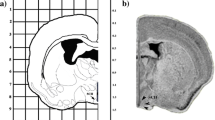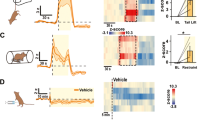The melanocortin (MC) system controls food consumption in the resting state. Stress suppresses food consumption. It is not clear whether the brain MC system is involved in the development of stress anorexia in mice. The aim of the present work was to study the influences of pharmacological blockade and activation of brain MC receptors on food consumption on the background of stress. Mice (male C57Bl/6J) were subjected to ether stress (ether anesthesia for 0.5 min) before administration of physiological saline or a synthetic nonselective antagonist (SHU9119) or agonist (melanotan II) of MC receptors into the lateral ventricle. Food consumption in all mice was stimulated by prior 17-h starvation. Ether stress decreased food consumption and increased the blood corticosterone level and the hypothalamic AgRP gene mRNA (a natural antagonist of MC receptors) level 1 h after application. Pharmacological blockade of central MC receptors on the background of stress weakened stress anorexia and decreased the hypothalamic AgRP mRNA level, while activation exacerbated stress anorexia and hypercorticism. Thus, these studies showed that the central MC system is involved in the development of stress anorexia in mice.
Similar content being viewed by others

References
N. M. Bazhan, E. N. Makarova, A. Yu. Shevchenko, and T. V. Yakovleva, “Repeated emotional stress prevents the development of melanocortin obesity and type 2 diabetes in mice with the Agouti yellow mutation,” Ros. Fiziol. Zh., 93, No. 11, 1237–1244 (2007).
A. A. Tinnikov and N. M. Bazhan, “Assay of glucocorticoids in plasma and adrenal incubation medium by competitive hormone binding by proteins without preliminary extraction,” Lab. Delo, No. 12, 709–713 (1984).
Z. A. Abdel-Malik, “Melanocortin receptors: their functions and regulation by physiological agonists and antagonists,” Cell Mol. Life Sci., 58, No. 3, 434–441 (2001).
N. M. Bazhan, T. V. Yakovleva, A. Y. Kazantseva, and E. N. Makarova, “Exaggerated anorexigenic response to restraint stress in Ay mice is associated with elevated CRFR2 mRNA expression in the hypothalamus,” Physiol. Behav., 120, No. 1, 19–25 (2013).
N. Bazhan and D. Zelena, “Food-intake regulation during stress by the hypothalamo-pituitary-adrenal axis,” Brain Res. Bull., 95, No. 1, 46–53 (2013).
S. Chaki, S. Ogawa, Y. Toda, et al., “Involvement of the melanocortin MC3 receptor in stress-related behavior in rodents,” Eur. J. Pharmacol., 474, No. 1, 95–101 (2003).
F. Chigr, F. Rachidi, C. Tardivel, et al., “Modulation of orexigenic and anorexigenic peptides gene expression in the rat DVC and hypothalamus by acute immobilization stress,” Front. Cell. Neurosci., doi: 10.3389/fncel.2014.000198. eCollection.
M. J. Cullen, N. Ling, A. C. Foster, and M. A. Pelleymounter, “Urocortin, corticotropin releasing factor-2 receptors and energy balance,” Endocrinology, 142, No. 3, 992–999 (2001).
W. A. Cupples, “Peptides that regulate food intake,” Am. J. Physiol. Regul. Integr. Comp. Physiol., 284, No. 6, 1370–1374 (2003).
J. De Souza, A. A. Butler, and R. D. Cone, “Disproportionate inhibition of feeding in A(y) mice by certain stressors: a cautionary note,” Neuroendocrinology, 72, No. 1, 126–132 (2000).
W. S. Dhillo, C. J. Small, L. J. Seal, et al., “The hypothalamic melanocortin system stimulates the hypothalamo-pituitary-adrenal axis in vitro and in vivo in male rats,” Neuroendocrinology, 75, No. 4, 209–216 (2002).
S. Fryer, G. Waller, and B. S. Kroese, “Stress, coping, and disturbed eating attitudes in teenage girls,” Int. J. Eat. Disord., 22, No. 4, 427–436 (1997).
K. Gartner, D. Buttner, K. Dohler, et al., “Stress response of rats to handling and experimental procedures,” Lab. Anim., 14, No. 3, 267–274 (1980).
H. J. Grill, A. B. Ginsberg, R. J. Seeley, and J. M. Kaplan, “Brainstem application of melanocortin receptor ligands produces long-lasting effects on feeding and body weight,” J. Neurosci., 18, No. 23, 10128–10135 (1998).
R. B. Harris, J. Zhou, M. Shi, et al., “Overexpression of agouti protein and stress responsiveness in mice,” Physiol. Behav., 73, No. 4, 599–608 (2001).
R. L. Hauger, V. Risbrough, O. Brauns, and F. M. Dautzenberg, “Corticotropin releasing factor (CRF) receptor signaling in the central nervous system: new molecular targets,” CNS Neurol. Disord., Drug Targets, 5, No. 4, 453–479 (2006).
J. J. G. Hillebrand, M. J. H. Kas, and R. A. H. Adan, “Alpha-MSH enhances activity-based anorexia,” Peptides, 26, No. 10, 1690–1696 (2005).
T. Imaki, J. L. Nahan, C. Riber, et al., “Differential regulation of corticotropin-releasing factor mRNA in rat brain regions by glucocorticoids and stress,” J. Neurosci., 11, No. 3, 585–599 (1991).
B. G. Irani, J. R. Holder, A. Todorovic, et al., “Progress in the development of melanocortin receptor selective ligands,” Curr. Pharm. Des., 10, No. 28, 3443–3479 (2004).
M. J. Kas, A. W. Bruijnzeel, J. R. Haanstra, et al., “Differential regulation of agouti-related protein and neuropeptide Y in hypothalamic neurons following a stressful event,” J. Mol. Endocrinol., 35, No. 1, 159–164 (2005).
J. Liu, J. C. Garza, H. V. Truong, et al., “The melanocortinergic pathway is rapidly recruited by emotional stress and contributes to stress-induced anorexia and anxiety-like behavior,” Endocrinology, 148, No. 11, 5531–5540 (2007).
K. J. Lookingland, J. W. Gunnet, and K. E. Moore, “Stress-induced secretion of alpha-melanocyte-stimulating hormone is accompanied by a decrease in the activity of tuberohypophysial dopaminergic neurons,” Neuroendocrinology, 53, No. 1, 91–96 (1991).
X. Y. Liu, G. S. Barsh, H. Akil, and S. J. Watson, “Interaction between α-melanocyte-stimulating hormone and corticotropin-releasing hormone in the regulation of feeding and hypothalamo-pituitary-adrenal responses,” J. Neurosci., 23, No. 21, 7863–7872 (2003).
S. Makino, K. Asaba, M. Nishiyama, and K. Hashimoto, “Decreased type 2 corticotropin-releasing hormone receptor mRNA expression in the ventromedial hypothalamus during repeated immobilization stress,” Neuroendocrinology, 70, No. 1, 160–167 (1999).
E. Minály, C. Fekete, R. M. Lechan, and Z. Liposits, “Corticotropinreleasing hormone-synthesizing neurons of the human hypothalamus receive neuropeptide Y-immunoreactive innervation from neurons residing primarily outside the infundibular nucleus,” Comp. Neurol., 446, No. 3, 235–243 (2002).
K. D. Mul, B. M. Spruijt, J. H. Brakkee, and R. A. H. Adan, “Melanocortin MC4 receptor-mediated feeding and grooming in rodents,” Eur. J. Pharmacol., 719, No. 2, 192–201 (2013).
B. E. Murphy, “Some studies of the protein binding of steroids and their application to the routine micro and ultramicro measurement of various steroids in body fl uids by competitive protein – binding radioassay,” J. Clin. Endocrinol. Metab., 27, 973–990 (1967).
S. Obici, Z. Feng, J. Tan, et al., “Central melanocortin receptors regulate insulin action,” J. Clin. Invest., 108, No. 7, 1079–1085 (2001).
G. Paxinos and K. Franklin, The Mouse Brain in Stereotaxic Coordinates, Academic Press, San Diego (1997).
M. A. Pelleymounter, M. Joppa, N. Ling, and A. C. Foster, “Pharmacological evidence supporting a role for central corticotropin-releasing factor (2) receptors in behavioral, but not endocrine, response to environmental stress,” J. Pharmacol. Exp. Ther., 302, No. 1, 145–152 (2002).
J. Preil, M. B. Müller, A. Gesing, et al., “Regulation of the hypothalamic-pituitary-adrenocortical system in mice defi cient for CRH receptors 1 and 2,” Endocrinology, 142, No. 11, 4946–4955 (2001).
G. N. Smagin, L. A. Howell, D. H. Ryan, et al., “The role of CRF2 receptors in corticotropin-releasing factor- and urocortin-induced anorexia,” Neuroreport, 9, 1601–1606 (1998).
A. Tabarin, Y. Diz-Chaves, D. Consoli, et al., “Role of the corticotropin-releasing factor receptor type 2 in the control of food intake in mice: a meal pattern analysis,” Eur. J. Neurosci., 26, No. 8, 2303–2314 (2007).
H. Van Herck, F. De Boer, A. P. M. Hesp, et al., “Orbital bleeding in rats while under diethylether anaesthesia does not influence telemetrically determined heart rate, body temperature, locomotor and eating activity when compared with anaesthesia alone,” Lab. Anim., 31, No. 1, 271–278 (1997).
A. V. Vergoni, A. Bertolini, J. E. Wikberg, and H. B. Schiöth, “Selective melanocortin MC4 receptor blockage reduces immobilization stress-induced anorexia in rats,” Eur. J. Pharmacol., 369, No. 1, 1–15 (1999).
J. C. Von Frijtag, G. Croiset, W. H. Gispen, et al., “The role of central melanocortin receptors in the activation of the hypothalamus-pituitary-adrenal axis and the induction of excessive grooming,” Brit. J. Pharmacol., 123, No. 8, 1503–1508 (1998).
B. Xu, E. H. Goulding, K. Zang, et al., “Brain-derived neurotrophic factor regulates energy balance downstream of melanocortin-4 receptor,” Nat. Neurosci., 6, No. 7, 736–742 (2003).
Author information
Authors and Affiliations
Corresponding author
Additional information
Translated from Rossiiskii Fiziologicheskii Zhurnal imeni I. M. Sechenova, Vol. 101, No. 12, pp. 1337–1346, December, 2012.
Rights and permissions
About this article
Cite this article
Bazhan, N.M., Kulikova, E.V., Makarova, E.N. et al. Studies of the Role of Brain Melanocortin Receptors in Suppressing Food Consumption in Ether Stress in Mice. Neurosci Behav Physi 47, 438–443 (2017). https://doi.org/10.1007/s11055-017-0418-y
Received:
Revised:
Published:
Issue Date:
DOI: https://doi.org/10.1007/s11055-017-0418-y



